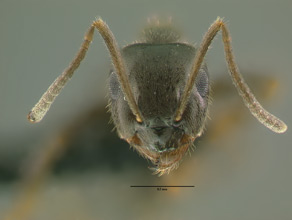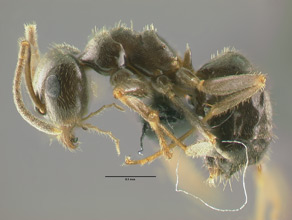- Identification
- Concolorous brown to blackish-brown workers. The legs may be a lighter shade than the body, with the scapes also light but in a slightly different shade of yellow brown color than the legs. Robust bodied workers that approach medium sized.
- Biology
- In North America Lasius niger typically nests under rocks. It occurs across a range of habitats, from open to wooded. Allred (1982) reports it was found in Utah in open areas, aspen, a grass-sagebrush-snowberry association, a maple-oak-fir stand, sagebrush and in fir. It also occurs at higher elevations within that state, most commonly between 4000 - 8000 ft, with roughly half of the 79 collections from montane areas.
- additional biology notes...
- Distribution
- Range
- United States and Eurasia. (from Wilson 1955) - This species has the northernmost range of the four members of the niger complex. In Eurasia it is found from Scotland and southern Fennoscandia south to Morocco, Algeria, and the offshore Atlantic Islands, east through Lebanon, Afghanistan, and the Himalayan plateau to central China and Formosa, then north to northern Russia, southern Yakutsk, and Kamchatka. In North America it ranges from the Pacific Northwest through most of the Great Basin, the Rocky Mountains, and northern Sierra Nevada.
- Navajo Reservation Records
- Samples being processed.
- Additional Notes
- This ant is quite common in Europe. At the time it was described by Linnaeus this was likely an ant that many people would frequently encounter and possibly be somewhat familiar with it.
- Allred (1982) described well the typical behavior of many Lasius, and in fact many ant species that form nest chambers under stones, when their nest covering is removed:
When the protective rock is removed, these ants run rapidly into their burrows and to the opposite side of the rock. Larvae that are present may be abandoned with no attempt on the part of the workers to carry them into deeper burrows. Sometimes those on the ground stay and work furiously to move the eggs and pupae into the burrows.
-
Wilson's (1955) account provides a nice overview of Lasius niger's biology (references provided within the following text are listed in the original publication):
Gosswald (1932) has presented a detailed and informative account of the habitat preferences and nesting habits of this species in Germany. He found it to be one of the most abundant and adaptable native ants. It occurs in deciduous, coniferous, and mixed forests, along forest borders, in hedgerows, and in open meadows; it thrives on cultivated land and occasionally enters houses. In forests it tends to nest in rotting tree trunks. In exposed situations with little vegetation cover, it nests mostly under stones. In meadows, along grass-grown paths and forest gardens, and in gardens, it frequently builds earthern mounds, especially where the soil is moist and the ground vegetation dense. Such mounds are irregular in shape and apparently designed to surmount the surrounding vegetation, with the result that they are often quite massive and may exceed 50 cm. in height. In a random field sample, Gosswald found 625 nests under stones, 350 in mounds, and 130 in rotting wood. The species is said to occasionally construct carton nests out of macerated plant material and humus, especially when it nests under stones in pine woods; the carton material closely resembles that characteristically manufactured by L. fuliginosus.
The North American population shows a similar latitude in habitat preferences. Field notes supplied me with 16 collections by A. C. Cole and Borys Malkin seem to indicate a general preference for drier and more open situations. The majority of the 16 were taken in open forest of variable composition, while several were taken in meadows and grassy roadstrips. One was taken in a dry rabbitbrush association (Chrysothamnus) near Eagle Nest, N. Mex. (Cole, see under distribution). Another was taken near timberline in a zone of stunted fir (Bloomington Peak, Wasatch Mts., Idaho; Malkin). The Eagle Nest colony was found in soil at the base of a bush; all of the others were taken under stones.
The previously published Asiatic records seem to indicate broad adaptability also. The Yalung-Yangtse collections recorded by Eidmann (1941) were made both in moist river valleys and in the high grassland of the Tibetan Plateau. All were from under stones. Kuznetzov-Ugamskij (1929a) notes that in the Ussuri region this species occurs under the "widest environmental conditions."
Ecological data accompanying several peripheral collections determined during this revision are noteworthy. On the Canary Islands (Gran Canaria, Teneriffe, La Palma) Wheeler (1927) found niger mostly in moist, shady spots between 1500 and 5000 feet. At Las Mercedes, Teneriffe (2500 feet), it was the only ant species found in a forest of tree-heath (Erica arborea) and laurel (Cerasus lusitanicus). At Ponta Delgada in the Azores niger occurred abundantly with Tetramorium caespitum, nesting under stones and foraging over the ground in files. In Lebanon, Christiansen (in litt.) took workers under rocks in mesophytic forest at Hammana and dealate queens from rotting wood in spruce forest above the Kammuoha Plain. Workers were also taken with the aid of a Berlese funnel from around the roots of grass growing on the banks of the Orontes River two miles south of Hermel. This last locality is surrounded by scrub desert and is ten miles from the nearest well developed woodland, representing an extreme habitat record for Lasius in general and a very extraordinary one for niger in particular.
Niger has generalized food habits. Many authors have observed it gathering insect remains, floral nectar, and the honeydew (excreta) of Homoptera and larval Lycaenidae. Eidmann (1926) and others have suggested that the insect honeydew makes up the bulk of the diet. According to Donisthorpe (1927), in a review of the food habits of this species, niger has been observed occasionally to gather seeds of such plants as Viola, Galium, and Ranunculus; Scott (1926) has seen it collecting seeds of Chelidonium. But apparently no one has checked to see if the seeds are actually used as food.
The pastoral habits of niger have been the subject of an excellent study by Eidmann (ibid.). Certain aphids overwinter in the nests of niger and are brought out and placed on the host plants in the spring. At first the aphids are returned to the shelter of the nests each evening. Later, as the nights grow warmer, the herds are left permanently in place. Certain of the workers function as guards (Wachter) during the day, remaining constantly at fixed posts; one worker was observed to return to the same spot each day for eight days. The workers appear to reduce predation by the braconid Trioxys, and on several occasions Eidmann saw them in the act of driving off workers of other ant species. Biisgen (1891) has observed niger workers combating chrysopid larvae in similar fashion. By counting the number of workers returning to the nest gorged with honeydew, Eidmann estimated that a large colony of niger may consume as much as a liter of this material in the course of a summer.
According to Eidmann, niger is principally nocturnal. Its above-ground activity, as measured by the number of ants soliciting honeydew, is highest at midnight and lowest in the early morning. The workers do all they can to avoid light; in order to work above ground they build turret-shaped shelters around the bases of aphid-infested plants and connect these with the nest by means of covered pathways.
Eidmann (1943) has included this species in a general study of overwintering in ants. Most of the workers of the colony move deep into the center of the nest, concentrating in a few chambers. A small number remain with the aphids in the special chambers where these insects are housed. Brood, in the form of small larvae, may be present or lacking.
According to Donisthorpe (1926), who has undertaken a thorough review of the European literature on the subject, the nuptial flights of niger take place in the afternoon and early evening from early JUly to mid-September. There are no records of nuptial flights in North America, but winged reproductives have been taken in nido from July 3 (Sacramento Mts., N. Mex.) to September 1 (Alta, Utah). Stray males and queens, possibly engaged in a nuptial flight, were found at Heber, Utah, on September 7 (A. W. Grundmann). Eidmann (1926) has studied reproduction and nest-founding in this species in Germany. The pair copulate in flight, fall to the ground, and separate. The queen, without attempting to take flight again, soon drops her wings and seeks cover. The first eggs are laid the following spring, and the first adult brood hatches that summer. One queen was observed to go without food for 382 days in the normal course of founding a colony. - Etymology
- Morphological. A reference to the dark brownish-black coloration that, to the naked eye, appears black.

- Literature
- Allred, D. M. 1982. Ants of Utah. Great Basin Naturalist. 42:415-511.
- Linnaeus, C. 1758. Systema naturae per regna tria naturae, secundum classes, ordines, genera, species, cum characteribus, differentiis, synonymis, locis. Tomus I. Editio decima, reformata. L. Salvii, Holmiae [= Stockholm].
- Wilson, E. O. 1955. A monographic revision of the ant genus Lasius. Bulletin of the Museum of Comparative Zoology at Harvard College. 113:1-201.
- A note about these publications. The literature cited here is not meant to be an exhaustive list of papers published about this species.
Page authored by David Lubertazzi and Gary Alpert


